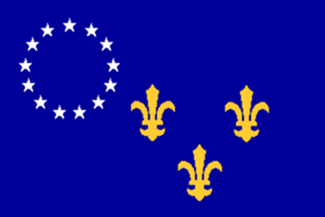 FLAGWAVER
FLAGWAVER
JOURNAL OF GREAT WATERS ASSOCIATION OF
VEXILLOLOGY
December, 2001
Vol. VI, No. 2, Issue 12

FRENCH INFLUENCE SEEN IN LOUISVILLE FLAG
SEE FLAGWAVER
JUNE, 2004 FOR NEW FLAG

One of the most attractively designed city flags in the United
States is that of Louisville, Kentucky's largest city. The ordinance of adoption
for the flag describes it in some detail, as follows:
The following described flag is hereby
adopted as the official flag of the City. A flag which shall have thirteen
silver stars and three gold fleur-de-lis placed upon a field of blue. The stars
shall be arranged in a circle in the first quarter after the manner of the
thirteen stars of the American flag as adopted by Congress, June 14, 1777. Two
gold fleur-de-lis shall be placed in the second quarter and one gold
fleur-de-lis shall be placed in the fourth quarter so that the three form a
triangle with the point at the bottom and the base at the top. The form of the
fleur-de-lis shall be the same as the "Middle Ages" fleurs-de-lis form
shown in the eleventh edition of the Encyclopedia Britannica, Volume 10, page
449. The blue of the flag shall be the same shade of blue as is in the field of
the American flag.
The flag's symbolism is explained by the city "as an
expression of the continuing good will between our people and the people of
France." Louisville, founded in 1778 by a band of settlers brought by
General George Rogers Clark to the place known as the Falls of Ohio, was named
for the French King Louis XVI, in recognition of the help the French had given
to the American colonists in their struggle for independence. Hence, the two
prominent designs on the flag; the gold fleur-de-lis to honor France, and the
thirteen silver stars to honor the original colonies and to commemorate the U.S.
flag in use at the time of the city 's founding.¹
Little more is known about the Louisville flag. The actual date
of adoption is cited variously as 1927 and 1934, although it would seem that it
may have been designed much earlier, if the reference to the Encyclopedia Britannica's
eleventh edition is any indication. That volume appeared in 1910-1911, so it is
likely that flag may have been developed closer to that time. The
designer's name is lost, but there is some indication that a committee designed
the flag, so that no one individual was credited. (JP)
¹The stars in a circle, of course, was just one of the arrangements
in early U.S. flags, but the circular form has acquired popular appeal in the
generations since as the typical U.S. flag of the 18th
century.
This was brought to the editors attention Sept. 17, 2007
It was posted online on the Brand Louisville website by the
grandson of the flags designer.
|
Written by Charlie Farnsley
|
| Wednesday,
15 August 2007 |
The Louisville Flag
On October 5, 1949, an ordinance was approved adopting an
official flag, for the City of Louisville. It was described
as follows:
"A flag which shall have thirteen silver stars and
three gold fleur-de-lis placed upon a field of blue. 'The
stars shall be arranged in a circle in the first quarter
after the manner of the thirteen stars of the American Flag
as adopted by Congress June 14, 1777. Two gold fleur-de-lis
shall be placed in the second quarter and one gold
fleur-de-lis shall be placed in the forth quarter so that
the three form a triangle with the point at the bottom and
the base at the top. The form of the fleur-de-lis shall be
the same as the "Middle Ages" fleur-de-lis form shown in the
eleventh edition of the Encyclopedia Brittanica, Volume 10,
page 499. The blue of the flag shall be the same shade of
blue as is in the field of the American Flag.'"
The adoption of this ordinance marked the culmination of
efforts on the part of Mayor Charles Farnsley to provide a
fitting symbol for the City. In its design he consulted flag
makers, historians, students of heraldry and others.
The flag tells a story. It is the story of a band of
frontiersmen fighting for independence who were grateful for
the aid sent to them by France and sought to show this
gratitude by naming their settlement for the French king. |

 FLAGWAVER
FLAGWAVER